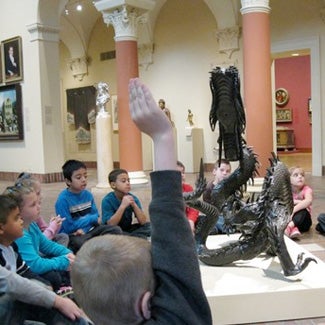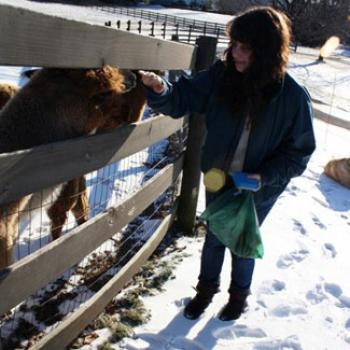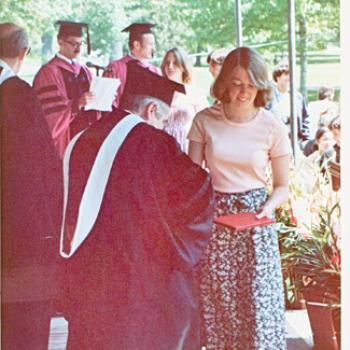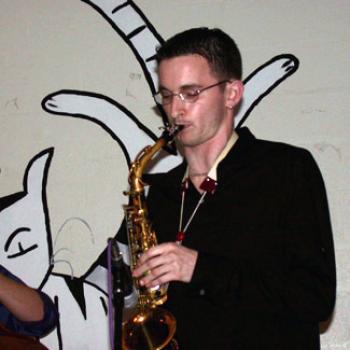On a change in perspective
Dessane Cassell ’14
“The distinction between my vantage point and that of the students had yielded entirely different interpretations of the work without us even realizing it.”

A fresh eye is always key. I have learned this over and over and over again in my time at Oberlin, and yet I still need a reminder every once in awhile. As an art history major, I spend the bulk of my time closely studying art objects, formulating theories about them by looking carefully and conducting research. The goal is to strike a balance between these two approaches — the experiential approach and the scholarly consideration of an object’s cultural and historical context. Yet in my own experience I have found that it is often easy to get so bogged down in one side of the work that it can be difficult to see the others — a problem most aptly described as being “too close” to your subject.
One of the most memorable experiences I have had confronting this tunnel-vision effect was during my second year at Oberlin, when I was giving a tour to a group of second graders at the Allen Memorial Art Museum. I had been struggling with an essay that I was writing on one of the sculptures in the museum, and I decided to include the sculpture among the objects I would show on my tour to see what kind of discussion it would generate. I had already done an extensive amount of research on the sculpture, yet I was still unsure how I wanted to approach it in my writing. Faced with the problem of being too close to my subject yet again, I thought I would enlist the aid of the second graders to help me see the work from a new perspective. At this point, I had been working as a docent at the museum for most of the semester, and I had gotten to know this particular group of students quite well. The class had visited the museum on several occasions, and the students had grown comfortable participating in discussion during their last few tours. I had a feeling they might have some interesting things to say about the work.
After discussing a few paintings, we moved into the AMAM’s sculpture court where I gathered them around Auguste Rodin’s Prodigal Son, a bronze sculpture of a single figure kneeling atop a rock with his back arched and head turned up to the sky. As usual, I asked the students to sit cross-legged in front of the work and take a few minutes to think about what they were looking at before we began our discussion. While the students had plenty to say about the previous works we had discussed, their hands shot up particularly quickly when I asked them to tell me what they saw in front of them. As I had hoped, they were eager to share their thoughts on the sculpture and our discussion of the work proved to be incredibly enlightening, and even humorous at times.
I was struck by how well the students were able to connect their knowledge of Christian themes with their impressions of the sculpture, but what was actually most memorable was the students’ discussion of an aspect I had not noticed. From their positions seated on the floor, the second graders saw the sculpture from an entirely different perspective than I did standing beside them. To the second graders, the figure’s posture created the impression that he was either communicating with God or thanking Him, making it seem as though he was rejoicing. To me, standing nearly level with the height of the sculpture, the figure’s body language pointed to a feeling of despair — he appeared downtrodden and in need of redemption. The distinction between my vantage point and that of the students had yielded entirely different interpretations of the work without us even realizing it.
At that point, I sat down on the floor next to the students and surely enough, I received the same impression of the sculpture that they did. I was thrilled; our discussion raised an important aspect of the work that I never would have noticed had I simply relied upon my own observations.
Needless to say, I had certainly found some additional inspiration for my essay.
Tags:
You may also like

On being an art history major
“Thirteen years later, as a freshman in college, I found the perfect outlet for my misguided artistic endeavors: art history.”
Georgia Horn ’12

On leaving Oberlin and returning
“What I thought must be standard fare at all colleges - the excellent music, the spectacular art museum, the earnest students - proved not to be standard at all.”
Emily Nord McClintock ’76

On finding his place at Oberlin
“For me, the goal in truth was not to become the best saxophone player there ever was. It was to experience the incredible wealth of opportunities that Oberlin had to offer.”
Jonah Berman ’03